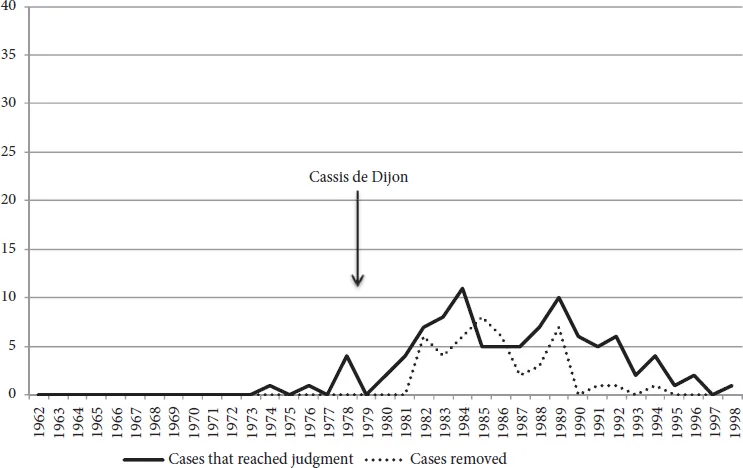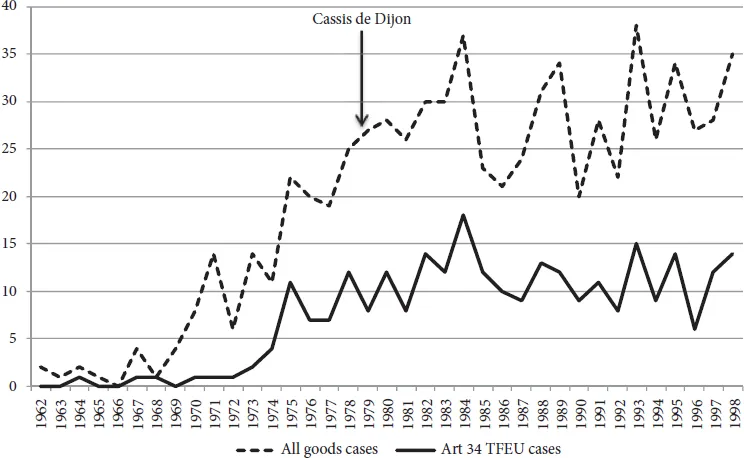I.Introduction
Identifying a suitable image for a book on a landmark case by the Court of Justice is challenging. The law is about rules, about principles, about the development, interpretation and contestation of ideas and concepts. The approach of the law does not lend itself to easy visualisation. But this is not quite true when it comes to Cassis de Dijon.1 As generations of lawyers, political scientists and even contemporary historians can testify, this is the landmark case2 associated with the image of a bottle: a bottle of the French blackcurrant liqueur, Cassis de Dijon.
Identifying a suitable image for this book, which examines the origins and legacy of the Cassis de Dijon case over 40 years, has nevertheless been challenging, particularly when seeking to avoid the clichéd depiction of a bottle of the French liqueur. The result of this effort is the nineteenth-century postcard on the cover of our book. The focus of this image is a map of the Département de la Côte d’or in eastern France, part of Burgundy, now the Bourgogne-Franche-Comté region, with the city of Dijon at its centre. The map is framed by local produce, including vegetables, fruit and, next to a couple of wine barrels, a bottle of Cassis. A boy on the left of the map, dressed in local attire and carrying a basket containing what looks like freshly picked grapes, further adds to the regional character of the image. At the same time, there is a red line around the Côte d’or, separating it from the surrounding départements on the map. Undoubtedly the demarcation line accentuates that the boy depicted here is part of and belongs to the Côte d’or area. While promoting the produce of this specific region, the image thus also addresses the issue of the boundaries of local and regional identity.3 Indeed, French wine has long served as an expression of social relations, and as a space for negotiating changing relationships between national and regional identities.4
Fast forward to 1979, when our landmark case was decided. Cassis de Dijon has an alcohol content of only 15 per cent. This meant that until the Court of Justice’s Cassis de Dijon decision, finding a breach of Article 34 of the Treaty on the Functioning of the European Union (TFEU), that beverage could not be sold in Germany, which insisted that fruit liqueurs had to have a minimum alcohol content of 25 per cent. The German Government was forced to defend its legislation on the grounds of public health – the purpose of the fixing of a minimum alcohol content was to avoid the proliferation of alcoholic beverages with a low alcohol content, which might ‘more easily induce a tolerance towards alcohol than more highly alcoholic beverages’. It was a dreadful argument and one that was rightly rejected by a sceptical Court; the Court was not much more enthusiastic about the other argument raised by the German government based on the fairness of commercial transactions.
II.What the Institutions did Next
Cassis de Dijon is famous for more than just this, however. The European Union (EU) law orthodoxy is that the Court created the principle of mutual recognition in Cassis de Dijon, but the full implications of the principle were tamed by the simultaneous development of the doctrine of mandatory requirements, now more commonly referred to as public interest requirements. Thus, with Cassis de Dijon, the basis for a non-absolute principle of mutual recognition was born, and this proved to be a turning point in the development of the single market.5 This is because the decision was rapidly seized upon by the Commission, frustrated by the slow realisation of free movement of goods, in its Communication on Cassis de Dijon.6 The principle of mutual recognition became the cornerstone for the EU’s new approach directives and its regime on qualifications and driving licences, as well as subsequently being rolled out to the area of freedom, security and justice.7
But the Commission’s activity embracing Cassis was not just about legislation. As Marcus Gehring has shown, the Commission built on the decision in Cassis through enforcement actions. Overall, from the Cassis de Dijon decision in 1979 to the signature of the Single European Act seven years later, 37 cases were brought to the Court of Justice challeging infringement of the Treaty provision on free movement of goods, of which 90 per cent were lost by the defendant Member State.8 In addition, 24 infringement cases were brought but withdrawn by the Commission when the Member State involved agreed to take action before the case was heard (see Figure 1.19).
Figure 1.1 Infringement actions on free movement of goods
So, in the immediate aftermath of Cassis de Dijon, approximately one in three infringement cases brought to the ECJ concerned the free movement of goods and were assessed according to the Cassis parameters.10
The rise in infringement actions on the free movement of goods and, in particular, the Cassis criteria can be compared to the spikes in preliminary references on the topics of the free movement of goods and measures equivalent to quantitative restrictions that followed Cassis de Dijon (Figure 1.2; same scale for comparison). If anything, the spike in infringement cases is more marked, although it can be suggested that the difference reflects the more contingent way in which preliminary references reach the Court of Justice.11 Thus it can be argued that the Commission’s use of infringement proceedings is a more straightforward route to the achievement of (negative) integration despite the more prolific nature of the preliminary reference case law.
Figure 1.2 Preliminary references on free movement of goods
The Commission’s adoption of the Cassis criteria also enabled it to address a further problem that systematically arises from relying on preliminary references to counter national non-compliance with EU legislation, which is the very uneven rate of referral between the Member States. As Table 1.1 indicates, some Member States see a high rate of preliminary references (PR) by their national courts as well as being the recipients of a relatively large number of direct actions by the Commission: for instance, France and Germany. Others, most notably the Netherlands and the UK, have been the subject of few actions by the Commission and have seen a high rate of preliminary references emerging from their courts. Member States such as Denmark, as well as Austria and Finland, that joined the EU only in 1995, have the reputation of being prompt and effective in their transposition and application of EU measures. These Member States are probably in the same position, in that the Commission has rarely, if ever, found it necessary to bring infringement actions against them.
Table 1.1 Litigation on free movement of goods
| 1961–1998 | Art 226 cases completed | Art 226 cases removed | PRs |
| Belgium | 10 | 6 | 26 |
| France | 16 | 15 | 59 |
| Germany | 15 | 4 | 47 |
| Italy | 23 | 11 | 38 |
| Luxembourg | 0 | 1 | 5 |
| Netherlands | 4 | 0 | 51 |
| Denmark | 1 | 0 | 8 |
| Ireland | 8 | 4 | 0 |
| UK | 5 | 0 | 21 |
| Greece | 14 | 6 | 2 |
| Portugal | 0 | 0 | 1 |
| Spain | 2 | 0 | 3 |
| Austria | 0 | 0 | 6 |
| Finland | 0 | 0 | 2 |
| Sweden | 0 | 0 | 6 |
| Total | 98 | 47 | 275 |
As Wolfers has argued,12 of the Member States that typically receive high numbers of actions from the Commission, however, Greece and Italy stand in contrast to each other. The litigation pattern with respect to Italy’s infringements resembles that of the other large founding Member States, in that there are large numbers of both direct actions by the Commission and preliminary references from the national level. Greek courts, however, have referred very few questions on the free movement of goods to the ECJ. In the case of Greece, therefore, almost all litigation on the topic has been initiated by the Commission, and it can be argued that the application of the Cassis ruling has been the main means by which compliance with EU law relating to the free movement of goods has been enforced.
III.The Best Days of Cassis de Dijon?
The orthodoxy of EU law identifies Cassis de Dijon as one of the leading cases of EU law.13 These leading cases, to use the (hyperbolic) words of Clark Hare and Wallace, are the ‘great “lighthouses of the law”, which never fail, are never dimmed, and are most visible in those times when the need for a guide is mostly felt’.14 But given that this case is so well known, why revisit it? Is there anything left to say? As this volume shows, there is. The 40th anniversary of the Court’s decision provides us with an opportunity to show how one case of crucial significance in the EU law orthodoxy can be re-examined by drawing on a range of diverse and multi-disciplinary angles.
A.The Context
The application of relative mutual recognition to the single market had two important consequences. On the one hand, this principle enabled the management of diverse rules reflecting local, regional and national preferences. The Cassis decision did not impose uniformity: it allowed for the continued existence of regional products, retaining the local character of beverages, as encapsulated by the image on our book cover. Cassis de Dijon enabled the wider dissemination and marketing of products associated with local, regional and national identities, in the emerging single market. In the same way, the decision fulfilled a key objective of the Commission ...


